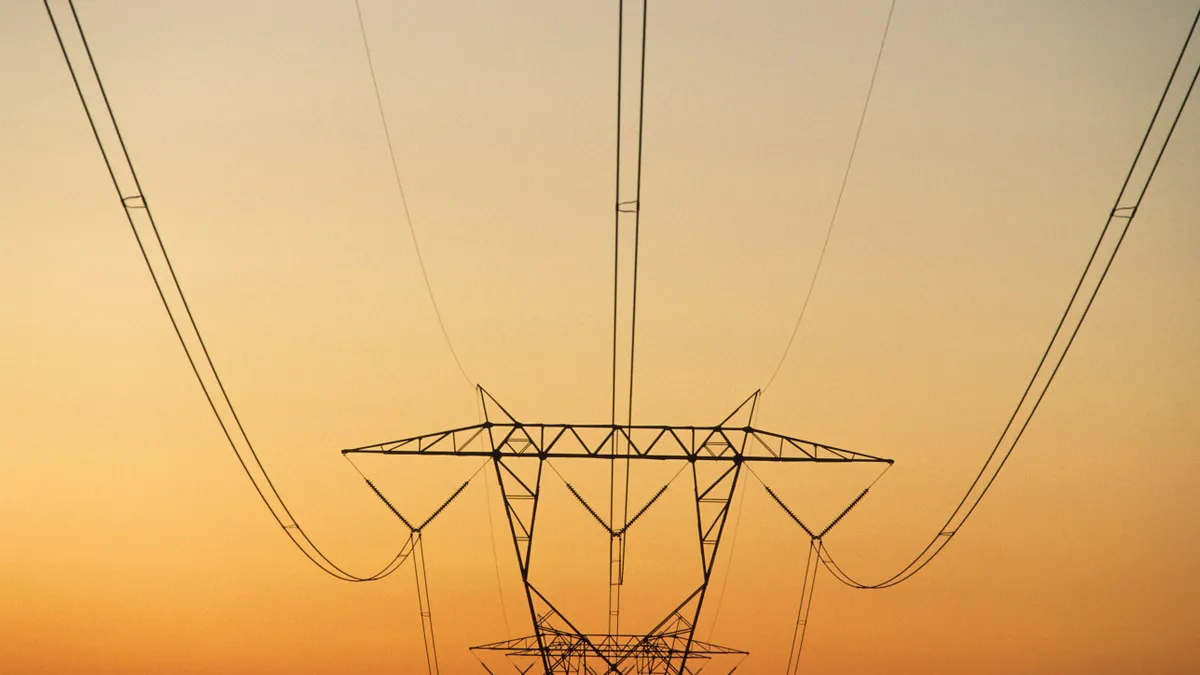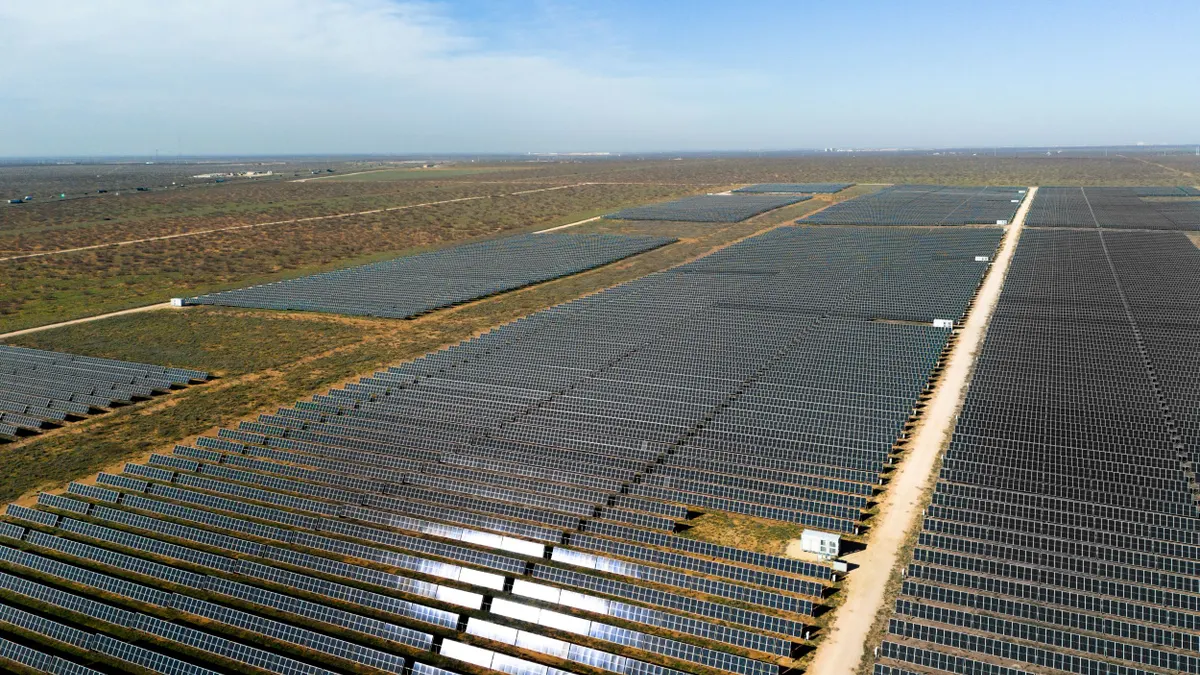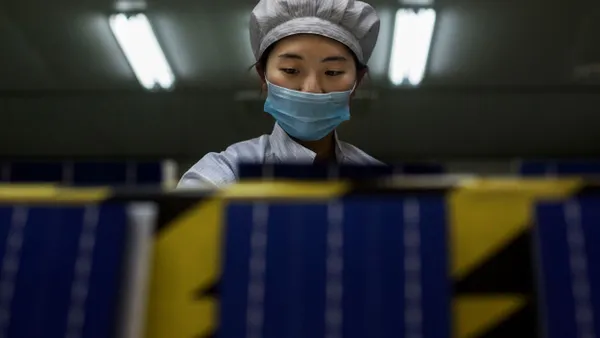In 2023, both the U.S. solar and offshore wind industries grew rapidly in spite of ongoing challenges posed by the global supply chain, the regulatory landscape, and interest rate hikes. Several offshore wind farms are nearing completion and two have already begun delivering power to the grid, while a record 33 GW of solar capacity was added to the U.S. grid last year.
Experts in both industries say they expect positive trends for these two renewable resources to continue this year, even as those challenges continue. The Inflation Reduction Act and the massive clean energy investments it’s generating play a significant role in that confidence, they say.
“For all of us in the [solar] industry, it’s a significant milestone legislation in that we're talking about a decade of certainty, which is a much different dynamic than having just a few years certainty,” said Eric Pollock, chief commercial officer at DSD Renewables.
Marlene Motyka, a principal at Deloitte and the firm’s U.S. renewable energy leader, said she sees the obstacles renewables face as “really just growing pains as the industry is scaling, rather than intractable issues that are going to stop the industry’s momentum.”
Both industries will face more challenges this year. In June, President Joe Biden’s two-year moratorium on any new tariffs on solar panels will expire. When the moratorium ends, an Aug. 18 U.S. Department of Commerce finding that four Southeast Asian countries circumvented tariffs on Chinese-made components will result in new duties on solar imports from those countries.
Solar imports also continue to be constrained by the Uyghur Forced Labor Prevention Act. In response to these pressures, the solar industry has been investing significantly in onshoring manufacturing, with several major factories announced last year.
Though module prices declined by almost 50% globally in 2023, and manufacturing capacity tripled from 2021 levels, replacing imports with domestically produced panels will increase the overall cost of deployment in the U.S., the International Energy Agency said in a January report.
“Looking at all of the investment decisions that have been made with module manufacturing and battery supply moving into the domestic market – that all has to be seen as an optimistic sign. Once those shovels go in the ground, and things start to really get built, my optimism will increase.”

Carl Newton
DSD Renewables’ vice president of strategic procurement and estimating
The offshore wind industry will see several developers attempting to rebid contracts they exited in 2023 during upcoming state solicitations, while the domestic workforce and supply chain needed to support offshore wind farms and their ports are being rapidly built out. As of this month, two utility-scale offshore farms are delivering power to the grid — a milestone in the U.S.
The arrival of utility-scale offshore wind power and the record explosion of solar capacity also mean that building new transmission and reducing the interconnection queue are more important than ever for the clean energy industry.
Proponents of clean energy hope to see the Federal Energy Regulatory Commission finalize its proposed transmission planning and cost allocation rule next year. Acting Chairman Willie Phillips said in November that the rule is a “chief” priority for him.
Offshore wind from scratch: ports, workforce and vessels
It may be a blessing in disguise for the offshore wind industry that so many developers had to delay or cancel projects last year, said Felisa Sanchez, of counsel with law firm K&L Gates’ maritime and finance groups.
“These cancelations are now allowing some breathing room that’s going to free up port availability, vessel availability,” she said. “There was a real crunch on and fight for those limited assets.”
Sanchez said she expects 2024 will “see the benefits of some of these rough waters” the industry has encountered in the past few months and “allow the supply chain to catch up a little bit.”
Bureau of Ocean Energy Management Director Liz Klein said that industry’s specialized vessel needs coupled with global post-COVID economic and supply chain difficulties have posed a number of challenges – but she remains “very, very optimistic” about this coming year.
“While any individual project might have a timeline that shifts, it's not an indication of failure, it's not an indication that this type of clean energy is not possible in the U.S.,” she told Utility Dive. “It just indicates that these are large, complicated endeavors.”
BOEM has four lease sales scheduled for 2024, and continues to work with other agencies to advance research and development into the floating offshore wind technology that will be needed to install turbines in the deep water off the West Coast.
“As projects are built here in the U.S., there will continue to be lessons learned by industry about the best way to move forward with construction,” Klein said. This includes innovation in equipment and vessels for both floating and fixed-bottom offshore wind farms.
The offshore wind industry’s development of necessary vessels has been hampered by the Jones Act, a 1920 law barring foreign vessels transporting goods by water. As a result, the U.S. industry has to implement workarounds to construct projects while building its own fleet of wind turbine installation vessels.
Dominion Energy is working on building the first such vessel, named Charybdis and expected to be completed late this year or early in 2025 for use on Dominion’s 2.6-GW Coastal Virginia Offshore Wind project.
In addition, the buildout of an offshore wind labor workforce remains a “work in progress,” Sanchez said. She’s seeing developers, contractors, vessel owners and port operators increasingly recruit from high schools and colleges, and work with maritime colleges to develop industry-specific training programs.
“The need for labor to build these projects is huge. I don't think that there's any developer or contractor out there that's going to tell you, ‘Oh, yes, we're very comfortable with our labor situation going into 2024.’”

Felisa Sanchez
Of counsel with law firm K&L Gates’ maritime and finance groups
Though BOEM’s first-ever lease sale in the Gulf of Mexico received a tepid response last year, only receiving bids on one of three areas put up for auction, Klein said the agency sees the region as “tremendously important” to offshore wind thanks to the “existing talent, infrastructure and equipment” created by the oil and gas industry.
Klein said that going forward, BOEM will have a significant focus on “supporting project proposals and making sure that we are being as efficient and effective as possible in our permitting reviews.”
“I think one of the ways to demonstrate the success of this type of technology, this type of clean energy, is to get projects built and delivering electrons to the grid,” she said. “There are a number of exciting milestones that we've hit, and I expect a lot more of the same in 2024. I am as aggressively optimistic as I have ever been about the prospect of offshore wind in the U.S.”
A push for onshoring will bring solar manufacturing stateside
After billions of dollars of planned investment in domestic solar manufacturing were announced last year, 2024 is set to see those investments pay off.
Domestic panel manufacturer First Solar, South Korea-based energy company Q Cells, India-based panel maker Waaree Energies, and the North American subsidiary of Italian company Enel all plan to bring new U.S. factories online this year.
While concerns linger about the fate of the solar supply chain once the tariff moratorium expires in June, Newton said that having Commerce’s final decision on the matter has been “extremely helpful” for DSD Renewables in terms of providing certainty on the issue.
“Tariffs, Customs and Border Protection issues, understanding the Uyghur Forced Labor Act – it’s still a relatively new thing for all of us,” he said. “We're all working our way through the supply chain mapping, and that's just another step that we all have to take in our due diligence. That said, as long as you do your due diligence, you shouldn't have problems with it.”
Newton said he thinks the impacts of the Inflation Reduction Act are still “shaking out,” but the biggest impact he’s seen so far is an increase in optimism worldwide.
“When you see that level of investment being made by fairly large global companies, it leads you to the understanding that this is seen as a viable long-term industry,” he said. “The momentum is there. And to be honest, it seems very unstoppable.”
However, Newton added that he sees uncertainty in the regulatory environment as the biggest hurdle the solar market faces.
“That tends to be more disruptive to us than anything else right now,” he said. “As far as equipment and material pricing, things are staying pretty steady. Module [prices] have declined quite a bit, actually, over the last six months.”
Motyka said she anticipates the impact of the investments generated by the IRA will come into view this year.
“A lot of producers are going to reshore, and new ones are going to come into the U.S. just to capitalize on those IRA tax credits and to help meet the demand from renewable developers who are chasing domestic content adders,” she said.
Deloitte’s view is that these investments, coupled with the demand generated by state, federal and corporate decarbonization goals, are forces that will “enable renewables to overcome recent hurdles,” Motyka said.
As solar capacity rapidly increases nationally, some hotspots of conflict have emerged on the state level — particularly when it comes to net-metered distributed solar.
Distributed solar advocates scored a win in Virginia in September when the State Corporation Commission struck down Dominion Energy’s interconnection parameters for certain net-metered projects, which the Virginia Distributed Solar Alliance argued posed “unreasonable” barriers to small solar projects.
But a three-judge panel for California’s First Appellate District Court in December dismissed a challenge brought against the California Public Utilities Commission’s latest update to the state’s net energy metering rule, which shrunk the compensation that customers with rooftop solar receive for exporting power back to the grid from their panels, and has been linked to job losses for small solar companies statewide.
“The general outlook is grim,” said Carlos Beccar, marketing director of Fresno-based solar company Energy Concepts Enterprises, about the state’s rooftop solar industry. “[2024] is going to be even worse. The job loss is going to probably double.”
Connecting to the grid
Transmission buildout and permitting reform remain critical priorities for the renewable energy industry as a whole. In addition, without faster and better grid interconnections, many of the decarbonization benefits of clean energy could be lost, analysts say.
In November, Princeton University’s ZERO Lab leader Jesse Jenkins said the previous decade’s annual average of 1% transmission capacity growth will have to rise to 2.3% in order to avoid cutting the IRA’s potential emissions reductions in half.
“When we think about the boosts coming from the IRA and [Infrastructure Investment and Jobs Act] to renewables, that can only exacerbate the pressure on the transmission bottleneck,” said Motyka. “That is a challenge that I don’t think is going to be lessened dramatically anytime soon, but there are a lot of parties working on that, from the RTO and ISO perspective as well as from the FERC side.”
In California in particular, wind and solar generation curtailments reached record highs last year. As of September, the Energy Information Administration found that the California Independent System Operator had curtailed more than 2.3 million MWh of wind and solar output in 2023.
Trade groups, clean energy groups and laboratories spent the last year sounding the alarm about the need for transmission buildout. Evergreen Action’s Power Sector Senior Policy lead Charles Harper said in December that he sees 2024 as a potentially significant year for transmission reform after FERC Commissioner James Danly’s term expired on Jan. 3.
Danly opposed FERC’s proposed transmission planning and cost allocation rule, and Harper said the group is now “really optimistic” about the potential for that and other transmission rules to pass this year.
“I don’t think the pressure [for transmission reform] is going to go away,” Motyka said. “I think it’s only going to increase, and there’s this resounding push and discussion around the fact that there is this generation that needs to be deployed as we continue to retire fossil generation.”
Correction: A previous version of this story misstated the timeline for an increase in solar module manufacturing capacity. It has tripled since 2021.























